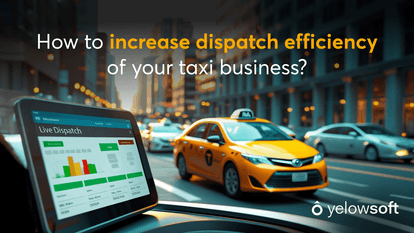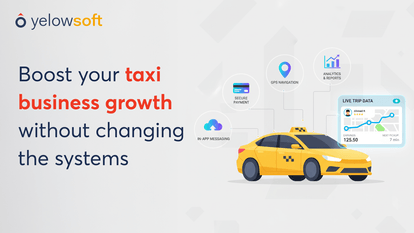Ride-sharing has become more than just a convenient travel option, it’s a full-fledged business opportunity.
Whether you're a startup or a transportation business looking to digitize, the ride-sharing industry continues to show immense promise.
But success in this space hinges on one major decision: the technology that powers your business.
Choosing the right ride-sharing app is a strategic move.
It's not just about picking an app that looks good, it’s about choosing a solution that can scale with your business, adapt to real-world demands, and deliver a seamless experience to drivers and passengers alike.
Let’s walk through the key things you need to evaluate before finalizing a ride-sharing solution that can support your goals and offer you long-term sustainability.
6 major factors to consider while choosing the best ride-sharing app
1. Avoid scripts or clone apps
Many new businesses are tempted by clone scripts of popular ride-sharing apps. They seem budget-friendly and promise quick deployment. But here’s the reality: these scripts often come with poor code quality, outdated technology stacks, a lack of flexibility, and limited support.
Once deployed, scaling them or making upgrades becomes nearly impossible without heavy investments. Not to mention the security vulnerabilities they can expose your platform to.
A white-label ride-sharing solution, on the other hand, offers more than just basic functionality. It gives you a ready-to-launch, professional-grade software that is fully tested, secure, and optimized for performance. The branding is yours, and the backend is maintained by a team that understands the product well.
It allows you to control your business flow while offering room to expand or modify based on real-time needs. In the long run, it’s more sustainable, easier to scale, and far more secure than any clone script on the market.
2. The app should serve both passengers and drivers efficiently
An ideal ride-sharing platform should come with two separate yet synchronized apps: one for passengers and one for drivers. The reason is simple: both users have different needs, and the app’s UI/UX should cater to those needs specifically.
For passengers, the booking process should be smooth, from entering pick-up and drop-off locations to selecting a vehicle type and tracking rides in real time. Payment should be easy, and communication with drivers should be built in.
On the driver's side, the app should enable them to go online/offline as per availability, receive ride requests, view navigation routes, and track earnings. A driver-friendly app helps in better service delivery and encourages retention by making their job easier.
Having well-structured apps for both users ensures operational harmony and helps your platform deliver a reliable experience every time.
Explore our user-friendly apps
Explore our user-friendly apps
3. Go for cloud-based ride-sharing software
Cloud technology is essential. Traditional ride-sharing platforms that rely on on-premise systems often face scalability issues and force operators to manage operations from a fixed physical office.
In contrast, cloud-based ride-sharing platforms offer true operational freedom. You can access your entire system from anywhere and monitor every aspect of your business in real time: bookings, driver locations, trip status, and analytics, all from a centralized dashboard. It allows for instant updates, auto-scaling in times of heavy traffic, and ensures high uptime even during peak demand.
Moreover, cloud-based infrastructure brings advanced security protocols. Your business data, user details, and trip history are stored safely and with better encryption, ensuring privacy and compliance. Plus, in today’s fast-paced mobility space, the flexibility to access your platform on the go becomes a competitive edge.
Explore our user-friendly apps
4. Evaluate the core features of the ride-sharing app
A ride-sharing app is only as good as the features it offers to drivers, passengers, and the admin. A feature-rich solution not only improves daily operations but also enhances user experience, reduces friction, and fosters brand trust. Below are the essential features every ride-sharing app should offer:
- Real-time ride tracking
This allows passengers and admins to track the driver's location live during the ride, offering better transparency and safety.
- In-app chat & call
Secure communication between the driver and the passenger ensures coordination without sharing personal contact details.
- Fare estimation & breakdown
Enables users to view an estimated fare before booking and see the complete breakdown post-ride, promoting trust and clarity.
- Multiple payment options
Offering digital wallets, UPI, card, and cash options ensures convenience for a wider audience and reduces payment friction.
- SOS/panic button
A built-in safety feature for both passengers and drivers that connects them to emergency services or internal support with one tap.
- Driver availability toggle
Allows drivers to set themselves online or offline based on their availability, offering flexibility and reducing idle time.
- Automated dispatching system
Assigns the nearest and most suitable driver to a booking request using smart algorithms, reducing wait times and improving efficiency.
- Rating & review system
After each ride, both drivers and passengers can rate each other and leave feedback, helping maintain quality standards.
- Scheduled rides
Enables users to book rides in advance, which is particularly useful for airport transfers or peak-hour commutes.
- Promo codes and discounts
A powerful marketing tool that helps attract new users and retain existing ones through time-limited offers or loyalty perks.
- Ride history and receipts
Both users and drivers can access past rides with complete details, which is helpful for references, disputes, or reimbursements.
- Admin dashboard & analytics
Provides real-time insights into operations, ride stats, user behavior, revenue, and performance metrics, helping businesses make informed decisions.
Explore all our features now
5. Customization is not optional anymore
Many first-time buyers assume ride-sharing apps are ready-to-use and should work as-is. But in reality, no two businesses have the exact same needs. That’s why customization is vital.
Yes, good customization often comes at an added cost. But it helps align the product with your business model, local regulations, target audience, and branding. A generic app might serve a basic use case, but without personalization, your app won’t stand out, and that directly affects user acquisition and retention.
Businesses that go for non-customizable solutions often struggle with limitations. They can’t adapt the app to new services like corporate bookings, women-only rides, or luxury fleets. Moreover, when expansion becomes a priority, whether to new cities or segments, lack of flexibility becomes a major roadblock.
Best-in-class ride-sharing platforms handle customization in a modular and structured manner. You can request tailored features, local language support, unique pricing strategies, or even integrate with third-party APIs. This flexibility ensures your app evolves as your business grows.
6. Always check reviews and ratings on trusted platforms
You can’t afford to go blind when selecting ride-sharing software. Fortunately, platforms like G2, Capterra, Trustpilot, and Software Advice provide detailed feedback from real users.
These reviews highlight the actual experience businesses have had with different solutions,
-
How the support is
-
How stable the app is
-
How responsive the company is to changes
-
How frequently updates are rolled out
Going through these reviews gives you clarity. Look out for patterns; if multiple users are complaining about the same thing, chances are it's a genuine concern. On the flip side, high ratings for ease of use, fast deployment, or excellent customer service are solid indicators of a reliable product.
These platforms also allow for comparisons, so you can stack multiple ride-sharing solutions side by side based on features, pricing, support quality, and other key parameters. It’s one of the smartest steps to take before making a final decision.
Conclusion
Building a ride-sharing business requires more than just an app. It demands a foundation that can scale, support diverse users, deliver smooth operations, and give you full control over branding and revenue. That’s why the choice of your technology partner is crucial.
Avoid shortcuts like clone scripts that might save you money now but cost you more in limitations later. Look for white-label platforms with proven success, reliable support, and the ability to evolve with your business. Ensure the app serves both passengers and drivers effectively, runs on cloud infrastructure, offers the right features, supports customization, and comes with positive feedback from other business users.
When you get these elements right, you’re not just choosing an app, you’re building a solid, future-ready ride-sharing business.
Grow your ride-sharing business with Yelowsoft




